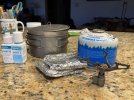If you're using store-bought dehydrated meals, get a pouch:
Keep your freeze-dried meals warm 30% longer without burning your fingers. The AlpineAire (H)EAT pouch works with most freeze-dried food pouches to insulate your meal while it cooks or while you eat.

www.rei.com
You can make them out of windshield sun screens, mailing pouches, etc, but that ^^^ is an example of a store-bought one that does make a big difference in rehydrating. Especially at altitude where the lower boiling point of water comes into play (194*f@10,000ft vs 212*f@ sea level). I'm on the edge of being an ultra-lighter, but more in the sense that I'll not carry items vs. carrying heavy items. I'm I'm carrying the weight of fancy dinners, a pouch is fine for the weight-price in that it makes them more enjoyable. On the flip side I'll carry no-cook meal options to drop weight instead of risking weather exposure by carrying only a puffy and no fleece in the mountains where rain can impact heavily.
I did a test once - I put an MSR fuel can (pressurized) for a Pocket Rocket stove in my deep freezer, and kept track of how much water I could boil with it versus one at 70* house temp by pulling it out and lighting it off outside in the mid-30s before it warmed any. I figured out that carrying a larger fuel can instead of the smallest I normally carried was more than enough to melt enough water for me for a particular trip I had planned. Yes, cold makes cans work less well. But if that's enough to make a meaningful impact on your trip, you should probably be carrying a liquid fuel stove.
In regards to backups; two stoves would be silly, just light a regular fire if you're that far up the creek. I love my Solo Stove but I'm not carrying it to backup a real stove because rocks exist and I can build a very small fire ring out of them. An eye dropper of bleach and an Esbit tablet will keep you from crapping yourself to death and you can light fires in the rain. Total weight is an ounce, IF you're on a trip where you need the time those buy you. Some trips you can drop gear and walk out before there are any real safety concerns if something breaks. Giardia isn't that bad after the first time.... also not as widespread as people worry about.
I've actually used the mini-stove for Esbit tablets, but not for "boiling" dinners, just to make non-cook trips more enjoyable in that I can have warm instant coffee in the morning. Some things I'm not willing to pass on, and hot coffee is worth the 4oz it add's to my pack.
Amazon.com: Esbit 11.5g (0.4 Ounce) Ultralight Folding Titanium Stove for Use with Solid Fuel Tablets: Liberty Mountain Sports: Sports & Outdoors
www.amazon.com
I have used yellow HEET (99% methanol) before and it does have a higher energy content than ethanol, but when I'm packing a penny stove I carry 190 proof Everclear. My thought process being that as I carry unsealed dehydrated foots, ethyl alcohol won't make me go blind if my fuel leaks on my food. Just not a risk I want to take, low percentage as it is.
Fun fact about HEET though.. everyone should carry a bottle in the winter. If you ever get really stuck somewhere bad in your vehicle, you take out your spare tire, CUT THE VALVE STEM OFF, (built a fire around the tire if there are any materials), pour the HEET on it and light the tire on fire. The SAR team will notice that kind of smoke signal.

